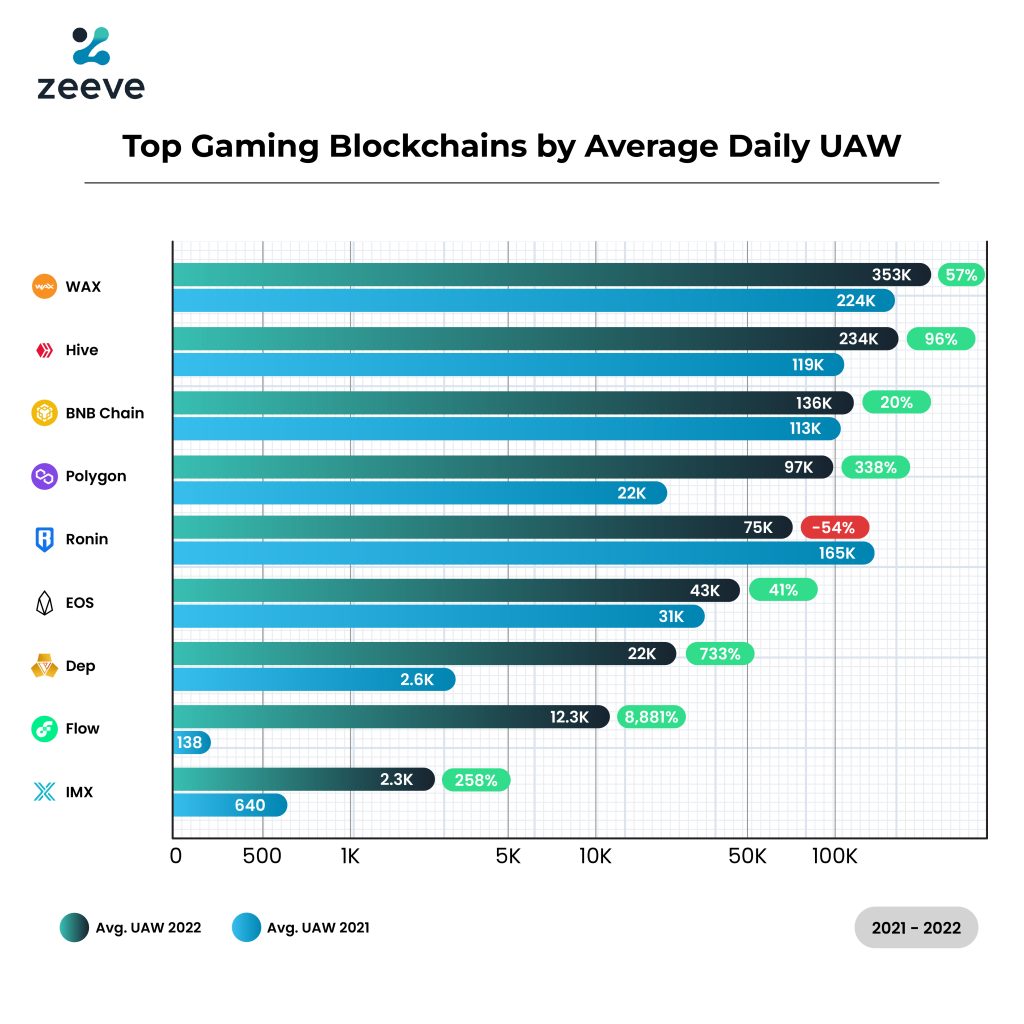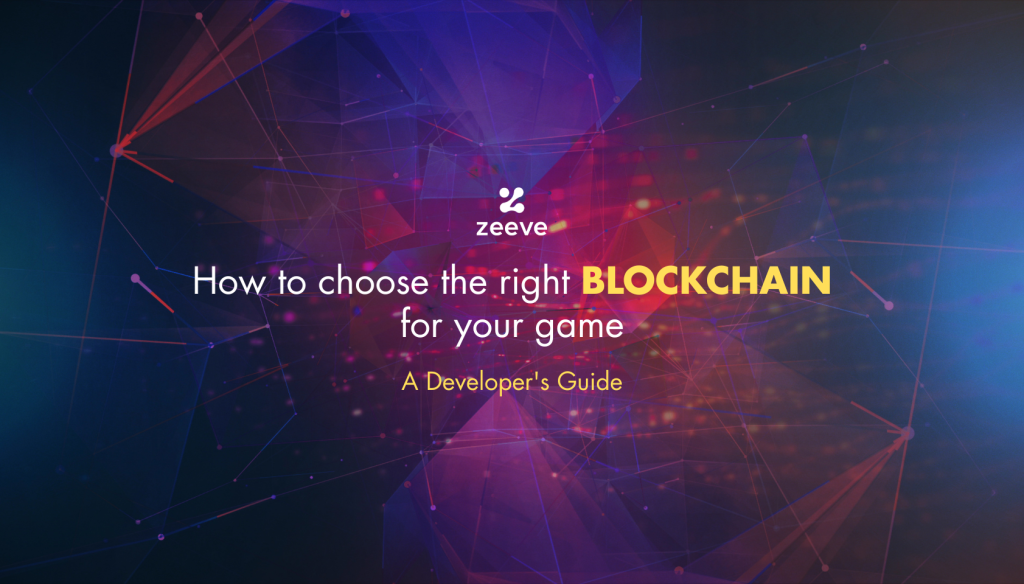The modern gaming industry requires high-performance infrastructure to deliver players an immersive and engaging experience. A typical infrastructure for a high-performance game comprises powerful servers, high-speed networks, and specialized devices such as GPUs to handle the demanding computational requirements. These components work together to ensure a smooth and seamless gaming experience with no lag or downtime. Do read this article for a Developer guide to choose blockchain for game.
For a long time, however, blockchains have been unable to deliver the level of performance required by the gaming industry, added with a lack of a ‘fun’ element in the gameplay. Most web3 gaming, therefore, is centered around the play-to-earn (P2E) model and less around simply playing for pleasure and recreation.
This has resulted in a lack of trust from game developers, who are concerned about the impact this could have on the player experience.
Despite these challenges, the situation is changing with a positive outlook.
With advances in blockchain technology and the growing awareness of its benefits, game developers are starting to find creative workarounds to overcome the limitations.
For example, some developers are using blockchain-based solutions for specific parts of the game, such as item trading and player-to-player transactions, while relying on traditional servers for real-time gameplay. New blockchain platforms are also emerging specifically designed for high-performance applications, offering the potential to deliver decentralized games that match or even exceed the performance of traditional centralized games.
In this article, we will see the major considerations and help you make an informed decision when it comes to choosing the right blockchain for your game.
Identify Your Needs
The first step is to identify your gaming application’s needs. Are you looking for an infrastructure that can handle large amounts of data? Are you looking for a blockchain where you can customize a lot of parameters?
Questions like these will guide your decision-making process when it comes to choosing the best blockchain for your game.
Usually, one of two types of blockchains are chosen when it comes to game development:
- Public blockchains
- Application specific blockchains
Public Blockchains
Most used as of now for building blockchain games.
Public blockchains are open-source, decentralized networks that are maintained by a global network of nodes.
One of the most important characteristics that a public blockchain should have for gaming is scalability. The blockchain needs to be able to process a large number of transactions in a short amount of time to support a fast-paced gaming environment. Binance Smart Chain, for example, is known for its high throughput and low latency, making it an ideal platform for real-time gaming applications.
Another important characteristic could be interoperability. Games running on a public blockchain should be able to integrate with other platforms and games to provide users with a seamless gameplay experience. Though this sounds nice, interoperability is hard to achieve and at large scale it’s close to impossible. But, same gaming studio, using same blockchain might provide interoperability more easily. That’s achievable and a few good ones are trying to get to that point. Hence, that factor is there also.
Public blockchains used in gaming should also have a strong focus on security. WAX, for example, is a blockchain platform that specializes in secure digital asset trading and management. The platform provides a secure infrastructure for the creation and trading of in-game assets. As per DappRadar’s report, WAX is the most popular blockchain for web3 gaming with 350,000 daily UAW (Unique Active Wallets) on average in 2022. Polygon is considered as the chain for games!
Here is the list of top public gaming blockchains for 2022.

The list isn’t comprehensive though and in the coming years, we will see new L1, L2s, or side chains being used for developing high-quality blockchain games.
Application Specific Blockchains
Application specific blockchains (appchains) are quite new in nature and not many gaming applications are not developed on them yet. But they are an excellent solution for web3 game development.
They are customizable, which means that developers can tailor the blockchain network to meet the specific requirements of the game. This customization enables game developers to create high-performance blockchain networks that are fast, low-cost, and scalable, allowing for a better gaming experience.
Polygon Supernet (powered by Polygon edge), Avalanche L1 (Formerly known as Subnets), Substrate chains are some examples.
Though all of them follow different technologies and design principles, the core idea is the same – building a dedicated blockchain that inherits the security and integrity of the root blockchain, keeping one specific application in mind.
Learn How appchains like Avalanche Subnet can fuel the next generation of gaming?
Well, a dedicated blockchain means, all your resources will be used for one application only, nothing shared like Public blockchains. No more surge in transaction fees in your RPG game, for rush in buying any specific NFT collection. You can choose your validators, specific hardware requirements if there is any, your payment token, fees and a lot of other things.
A whole lot of flexibility, right? You benefit from the horizontal scaling where TPS can reach in order of millions with a strong L1 security.
Factors to Consider When Choosing a Blockchain for Your Game
Once you have identified the type of blockchain that best suits your needs, there are certain factors to consider when making your decision.
Here are a few.
Transaction Fees
Transaction fees are one of the most significant factors when it comes to choosing a blockchain for your game.
If your target audience is large and you want your game to be adopted by a large group of people, you must ensure that the network’s transaction fee is low enough for anyone to make multiple transactions a day in the gameplay.
This is especially important for games that rely on micropayments like in-game purchases or frequent player-to-player trades.
Further, if game progress has to be saved, it should be recorded on the distributed ledger. This would mean a blockchain state change, which is again associated with a transaction fee.
So, keep transaction fees in mind to choose a blockchain that is player-centric.
Scalability
If you are developing a game that, say, involves thousands of players, you must make sure that the blockchain can scale accordingly.
For example, if your game requires real-time gaming experience, you must ensure that the blockchain is capable of handling thousands of transactions every second.
The scalability of a blockchain depends on its architecture, consensus mechanism, and other parameters. Be sure to consider these factors when selecting the right blockchain for your game.
You can choose to develop your game and its assets on an off-chain solution like Polygon, Optimism, or Arbitrum. This will enable you to provide a smoother gaming experience with lower transaction fees while deriving their security from the main chain.
Decentralization
The primary goal of evolving to blockchain-based games is a decentralized experience of gameplay that fosters unmediated player-to-player trades, provable scarcity, and verifiable ownership of assets.
Complete control over their digital assets within the game, such as characters, weapons, and in-game currency, leads to a more immersive and equitable gaming experience, as players are not at the mercy of a centralized entity that can manipulate the game or change the rules without their consent.
Additionally, game developers can benefit from new revenue streams and reduced risk of cheating, leading to increased player engagement.
By choosing a suitable blockchain and optimizing smart contract code, game developers can overcome these trade-offs and provide a more immersive and equitable gaming experience for players.
Lag and Latency: The Devils Of Blockchain Games
Latency and lag are two of the biggest challenges faced by blockchain gaming developers.
In the context of blockchain gaming, latency refers to the delay between the time a user sends a transaction to the blockchain network and the time it is confirmed and processed by the network. Lag refers to the delay between the time an event takes place in the game and the time it is reflected on the user’s screen.
In traditional gaming, these issues are managed by centralized servers that handle all the game data and transactions. However, in web3 games or blockchain gaming, everything needs to be decentralized ideally,
Learn more on Web3 Gaming: A deep dive for players & Developers
Here, all transactions and game data are recorded on a public ledger that is maintained by a network of nodes. This decentralized architecture makes it difficult to guarantee low latency and eliminate lag in the game. One of the main contributors to latency in blockchain gaming is the consensus mechanism used by the blockchain network.
Another contributor to latency and lag is the number of nodes in the network, their location, etc. The more nodes in the network, the more time it takes for a transaction to be processed and confirmed. This is because each node must validate the transaction before it can be added to the blockchain.
In addition, the performance of individual nodes can also affect the overall performance of the network. Nodes that are slower or have lower processing power can slow down the network and contribute to latency and lag.
But this part can be managed!
The Benefits of Using a Blockchain Infrastructure Platform like Zeeve For Game Development:
Developers who are looking to create blockchain-based games have an easier time using a development platform like Zeeve.
With Zeeve, game developers no longer have to worry about downtime, response times, DevOps, NodeOps and other issues that can impact the availability and security of their blockchain nodes, or APIs.
Support for Top Gaming Blockchains
Zeeve supports a wide range of top gaming blockchains (public, appchains and enterprise), including Polygon Edge, Aptos, Binance Smart Chain (BSC), Avalanche L1 (Formerly known as Subnets), and Substrate chains. This makes it easy for game developers to take advantage of the unique features offered by each blockchain.
On-Demand Scaling
When launching a new game, you never know for sure how overwhelming or underwhleming the community response could be. If there are more number of users than expected, you should be able to scale instantly without downtime. Similarly, if there are too few users, it is best to save up resources.
Zeeve provides on-demand scaling, which allows developers to quickly add or remove resources to adjust the capacity of the game according to user demand.
In-Depth Monitoring
In-depth monitoring and alerts are also critical for ensuring the node performance, security, and reliability of gaming applications. With Zeeve, developers can gain insights into the health and performance of their blockchain infrastructure, ensuring that they can quickly identify and resolve any issues that may arise.
With over 23000+ developers, 100+ large enterprises, and 4000+ nodes deployed, Zeeve is the preferred provider of blockchain infrastructure for all popular blockchain protocols.
Want to learn more about how we can help? Connect with us today and see how Zeeve can simplify your game deployment experience. Get started with Zeeve today.






















